Boaz Rafaely
AmbiDrop: Array-Agnostic Speech Enhancement Using Ambisonics Encoding and Dropout-Based Learning
Sep 18, 2025Abstract:Multichannel speech enhancement leverages spatial cues to improve intelligibility and quality, but most learning-based methods rely on specific microphone array geometry, unable to account for geometry changes. To mitigate this limitation, current array-agnostic approaches employ large multi-geometry datasets but may still fail to generalize to unseen layouts. We propose AmbiDrop (Ambisonics with Dropouts), an Ambisonics-based framework that encodes arbitrary array recordings into the spherical harmonics domain using Ambisonics Signal Matching (ASM). A deep neural network is trained on simulated Ambisonics data, combined with channel dropout for robustness against array-dependent encoding errors, therefore omitting the need for a diverse microphone array database. Experiments show that while the baseline and proposed models perform similarly on the training arrays, the baseline degrades on unseen arrays. In contrast, AmbiDrop consistently improves SI-SDR, PESQ, and STOI, demonstrating strong generalization and practical potential for array-agnostic speech enhancement.
Loss functions incorporating auditory spatial perception in deep learning -- a review
Jun 24, 2025Abstract:Binaural reproduction aims to deliver immersive spatial audio with high perceptual realism over headphones. Loss functions play a central role in optimizing and evaluating algorithms that generate binaural signals. However, traditional signal-related difference measures often fail to capture the perceptual properties that are essential to spatial audio quality. This review paper surveys recent loss functions that incorporate spatial perception cues relevant to binaural reproduction. It focuses on losses applied to binaural signals, which are often derived from microphone recordings or Ambisonics signals, while excluding those based on room impulse responses. Guided by the Spatial Audio Quality Inventory (SAQI), the review emphasizes perceptual dimensions related to source localization and room response, while excluding general spectral-temporal attributes. The literature survey reveals a strong focus on localization cues, such as interaural time and level differences (ITDs, ILDs), while reverberation and other room acoustic attributes remain less explored in loss function design. Recent works that estimate room acoustic parameters and develop embeddings that capture room characteristics indicate their potential for future integration into neural network training. The paper concludes by highlighting future research directions toward more perceptually grounded loss functions that better capture the listener's spatial experience.
BSM-iMagLS: ILD Informed Binaural Signal Matching for Reproduction with Head-Mounted Microphone Arrays
Jan 30, 2025

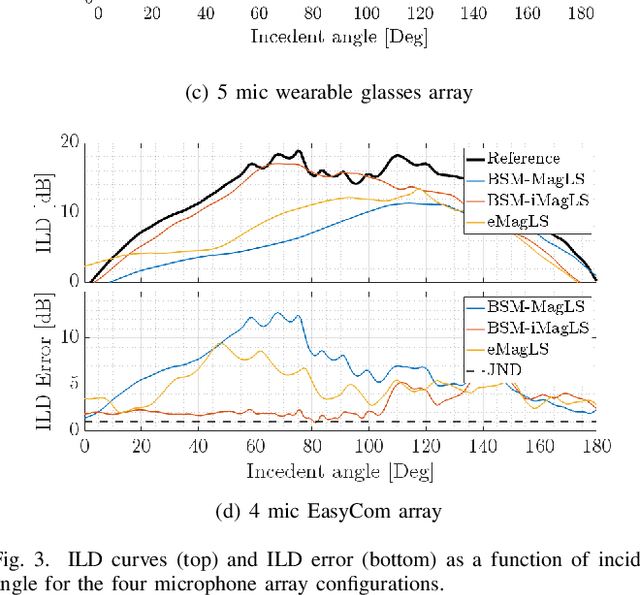

Abstract:Headphone listening in applications such as augmented and virtual reality (AR and VR) relies on high-quality spatial audio to ensure immersion, making accurate binaural reproduction a critical component. As capture devices, wearable arrays with only a few microphones with irregular arrangement face challenges in achieving a reproduction quality comparable to that of arrays with a large number of microphones. Binaural signal matching (BSM) has recently been presented as a signal-independent approach for generating high-quality binaural signal using only a few microphones, which is further improved using magnitude-least squares (MagLS) optimization at high frequencies. This paper extends BSM with MagLS by introducing interaural level difference (ILD) into the MagLS, integrated into BSM (BSM-iMagLS). Using a deep neural network (DNN)-based solver, BSM-iMagLS achieves joint optimization of magnitude, ILD, and magnitude derivatives, improving spatial fidelity. Performance is validated through theoretical analysis, numerical simulations with diverse HRTFs and head-mounted array geometries, and listening experiments, demonstrating a substantial reduction in ILD errors while maintaining comparable magnitude accuracy to state-of-the-art solutions. The results highlight the potential of BSM-iMagLS to enhance binaural reproduction for wearable and portable devices.
Ambisonics Binaural Rendering via Masked Magnitude Least Squares
Jan 30, 2025



Abstract:Ambisonics rendering has become an integral part of 3D audio for headphones. It works well with existing recording hardware, the processing cost is mostly independent of the number of sound sources, and it elegantly allows for rotating the scene and listener. One challenge in Ambisonics headphone rendering is to find a perceptually well behaved low-order representation of the Head-Related Transfer Functions (HRTFs) that are contained in the rendering pipe-line. Low-order rendering is of interest, when working with microphone arrays containing only a few sensors, or for reducing the bandwidth for signal transmission. Magnitude Least Squares rendering became the de facto standard for this, which discards high-frequency interaural phase information in favor of reducing magnitude errors. Building upon this idea, we suggest Masked Magnitude Least Squares, which optimized the Ambisonics coefficients with a neural network and employs a spatio-spectral weighting mask to control the accuracy of the magnitude reconstruction. In the tested case, the weighting mask helped to maintain high-frequency notches in the low-order HRTFs and improved the modeled median plane localization performance in comparison to MagLS, while only marginally affecting the overall accuracy of the magnitude reconstruction.
The importance of spatial and spectral information in multiple speaker tracking
Oct 15, 2024Abstract:Multi-speaker localization and tracking using microphone array recording is of importance in a wide range of applications. One of the challenges with multi-speaker tracking is to associate direction estimates with the correct speaker. Most existing association approaches rely on spatial or spectral information alone, leading to performance degradation when one of these information channels is partially known or missing. This paper studies a joint probability data association (JPDA)-based method that facilitates association based on joint spatial-spectral information. This is achieved by integrating speaker time-frequency (TF) masks, estimated based on spectral information, in the association probabilities calculation. An experimental study that tested the proposed method on recordings from the LOCATA challenge demonstrates the enhanced performance obtained by using joint spatial-spectral information in the association.
Improved direction of arrival estimations with a wearable microphone array for dynamic environments by reliability weighting
Sep 22, 2024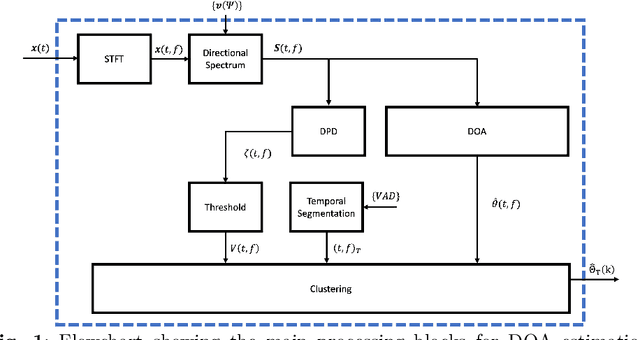
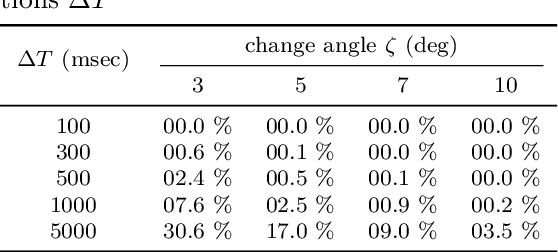
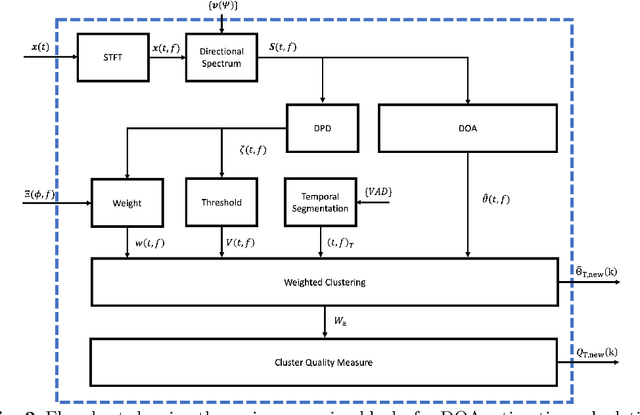
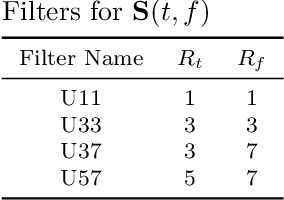
Abstract:Direction-of-arrival estimation of multiple speakers in a room is an important task for a wide range of applications. In particular, challenging environments with moving speakers, reverberation and noise, lead to significant performance degradation for current methods. With the aim of better understanding factors affecting performance and improving current methods, in this paper multi-speaker direction-of-arrival (DOA) estimation is investigated using a modified version of the local space domain distance (LSDD) algorithm in a noisy, dynamic and reverberant environment employing a wearable microphone array. This study utilizes the recently published EasyCom speech dataset, recorded using a wearable microphone array mounted on eyeglasses. While the original LSDD algorithm demonstrates strong performance in static environments, its efficacy significantly diminishes in the dynamic settings of the EasyCom dataset. Several enhancements to the LSDD algorithm are developed following a comprehensive performance and system analysis, which enable improved DOA estimation under these challenging conditions. These improvements include incorporating a weighted reliability approach and introducing a new quality measure that reliably identifies the more accurate DOA estimates, thereby enhancing both the robustness and accuracy of the algorithm in challenging environments.
Insights into the Incorporation of Signal Information in Binaural Signal Matching with Wearable Microphone Arrays
Sep 18, 2024Abstract:The increasing popularity of spatial audio in applications such as teleconferencing, entertainment, and virtual reality has led to the recent developments of binaural reproduction methods. However, only a few of these methods are well-suited for wearable and mobile arrays, which typically consist of a small number of microphones. One such method is binaural signal matching (BSM), which has been shown to produce high-quality binaural signals for wearable arrays. However, BSM may be suboptimal in cases of high direct-to-reverberant ratio (DRR) as it is based on the diffuse sound field assumption. To overcome this limitation, previous studies incorporated sound-field models other than diffuse. However, this approach was not studied comprehensively. This paper extensively investigates two BSM-based methods designed for high DRR scenarios. The methods incorporate a sound field model composed of direct and reverberant components.The methods are investigated both mathematically and using simulations, finally validated by a listening test. The results show that the proposed methods can significantly improve the performance of BSM , in particular in the direction of the source, while presenting only a negligible degradation in other directions. Furthermore, when source direction estimation is inaccurate, performance of these methods degrade to equal that of the BSM, presenting a desired robustness quality.
Assessing the Potential Impact of Direction-Dependent HRTF Selection on Sound Localization Accuracy
Aug 08, 2024Abstract:This study investigates the approach of direction-dependent selection of Head-Related Transfer Functions (HRTFs) and its impact on sound localization accuracy. For applications such as virtual reality (VR) and teleconferencing, obtaining individualized HRTFs can be beneficial yet challenging, the objective of this work is therefore to assess whether incorporating HRTFs in a direction-dependent manner could improve localization precision without the need to obtain individualized HRTFs. A localization experiment conducted with a VR headset assessed localization errors, comparing an overall best HRTF from a set, against selecting the best HRTF based on average performance in each direction. The results demonstrate a substantial improvement in elevation localization error with the method motivated by direction-dependent HRTF selection, while revealing insignificant differences in azimuth errors.
Feasibility of iMagLS-BSM -- ILD Informed Binaural Signal Matching with Arbitrary Microphone Arrays
Aug 07, 2024

Abstract:Binaural reproduction for headphone-centric listening has become a focal point in ongoing research, particularly within the realm of advancing technologies such as augmented and virtual reality (AR and VR). The demand for high-quality spatial audio in these applications is essential to uphold a seamless sense of immersion. However, challenges arise from wearable recording devices equipped with only a limited number of microphones and irregular microphone placements due to design constraints. These factors contribute to limited reproduction quality compared to reference signals captured by high-order microphone arrays. This paper introduces a novel optimization loss tailored for a beamforming-based, signal-independent binaural reproduction scheme. This method, named iMagLS-BSM incorporates an interaural level difference (ILD) error term into the previously proposed binaural signal matching (BSM) magnitude least squares (MagLS) rendering loss for lateral plane angles. The method leverages nonlinear programming to minimize the introduced loss. Preliminary results show a substantial reduction in ILD error, while maintaining a binaural magnitude error comparable to that achieved with a MagLS BSM solution. These findings hold promise for enhancing the overall spatial quality of resultant binaural signals.
Design and Analysis of Binaural Signal Matching with Arbitrary Microphone Arrays
Aug 07, 2024Abstract:Binaural reproduction is rapidly becoming a topic of great interest in the research community, especially with the surge of new and popular devices, such as virtual reality headsets, smart glasses, and head-tracked headphones. In order to immerse the listener in a virtual or remote environment with such devices, it is essential to generate realistic and accurate binaural signals. This is challenging, especially since the microphone arrays mounted on these devices are typically composed of an arbitrarily-arranged small number of microphones, which impedes the use of standard audio formats like Ambisonics, and provides limited spatial resolution. The binaural signal matching (BSM) method was developed recently to overcome these challenges. While it produced binaural signals with low error using relatively simple arrays, its performance degraded significantly when head rotation was introduced. This paper aims to develop the BSM method further and overcome its limitations. For this purpose, the method is first analyzed in detail, and a design framework that guarantees accurate binaural reproduction for relatively complex acoustic environments is presented. Next, it is shown that the BSM accuracy may significantly degrade at high frequencies, and thus, a perceptually motivated extension to the method is proposed, based on a magnitude least-squares (MagLS) formulation. These insights and developments are then analyzed with the help of an extensive simulation study of a simple six-microphone semi-circular array. It is further shown that the BSM-MagLS method can be very useful in compensating for head rotations with this array. Finally, a listening experiment is conducted with a four-microphone array on a pair of glasses in a reverberant speech environment and including head rotations, where it is shown that BSM-MagLS can indeed produce binaural signals with a high perceived quality.
 Add to Chrome
Add to Chrome Add to Firefox
Add to Firefox Add to Edge
Add to Edge